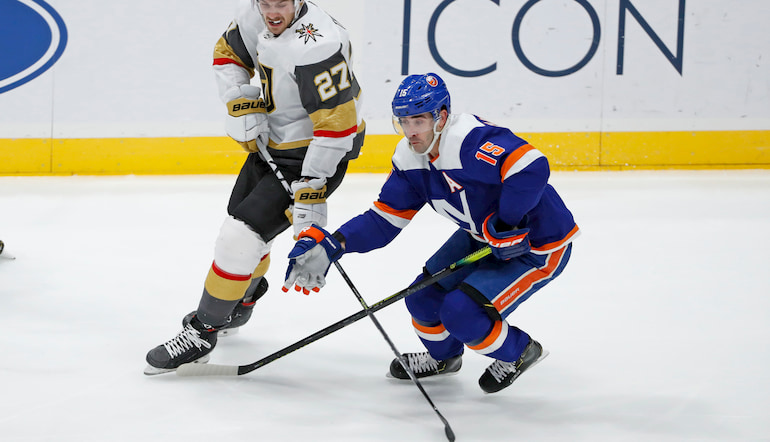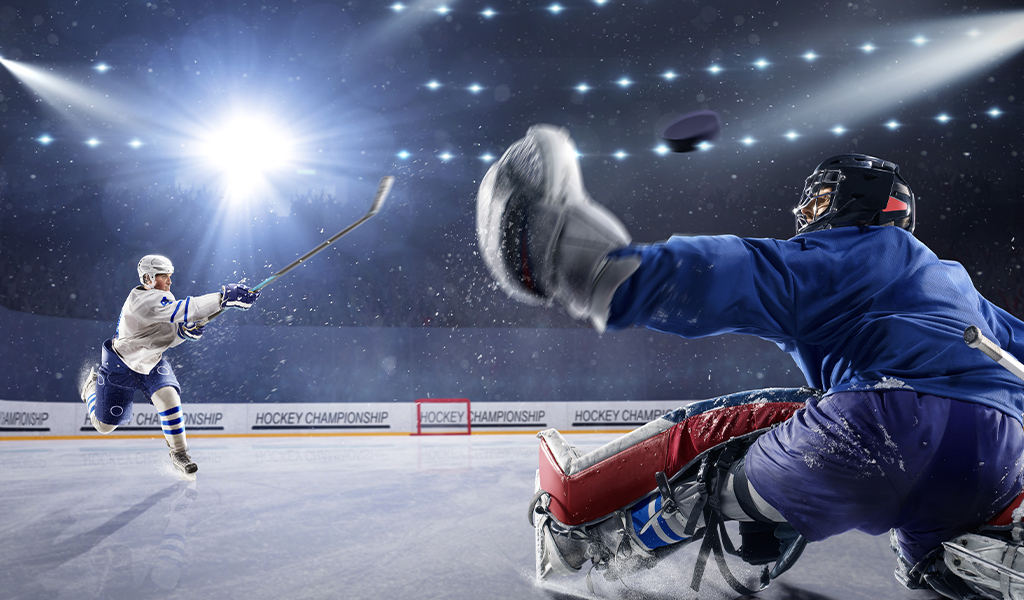Hockey is one of the fastest and most exciting sports in the world, and betting it can be equally exciting. While handicapping and picking winners is usually the focal point, there are a wide variety of different ways to wager on hockey. Here are some descriptions of the various types of hockey bets.

Money Line – Money lines are simply betting on which team will win the game outright, and is the most straightforward and popular type of hockey bet. Games featuring two teams with the same juice on both sides such as -110 each (bet $110 to win $100) are extremely rare, as there is almost always at least a slight favorite. Home ice advantage often plays a big role in how the lines are set. Top teams at home against lower-level teams can be huge favorites (up into the -300 range, bet $300 to win $100). This in turn leads to big prices on underdogs (in the +250 range, bet $100 to win $250).

Over/Under – Bookmakers set a total for each game and bettors wager on whether the total amount of goals scored between the two teams will go over or under that set total, that is how over/unders work. The total is almost always set in the 5.0 to 6.0 range, with the majority of games set at 5.5. 5.0 is a key number because since the shootout was instituted, there are no longer ties in hockey, and the shootout winner is awarded a goal. Therefore, every game that goes to overtime 2-2 will result in a 3-2 final score, or a push at Over/Under 5.0. Bettors generally have to pay extra juice when betting the OVER 5.0 or UNDER 5.5.


Betting On Hockey Explained
- The popularity of NHL betting has risen exponentially in recent years, thanks in large part to the meteoric rise of the Vegas Golden Knights and the growing overall interest in sports gambling as more and more states legalize betting. However, hockey remains a unique and tricky sport to bet on for several key reasons.
- Tips for Betting Hockey Point Spreads. There are a number of ways to pick out a strategy that works for you, what we would call the hockey point spread betting tips. Like everything in life, sports betting and hockey games can get complicated, unpredictable, and hard to bet on if you are just getting in the game.
Puck Line – As opposed to betting games on the moneyline, bettors can opt to play the puck line, in which each game has a set point spread of -1.5 on the favorite and +1.5 on the underdog. Wagering the puck line favorite at -1.5 offers a much more attractive price than the money line does, while betting the underdog +1.5 adds some security for more juice. One huge advantage for underdog puckline bettors is overtime, where +1.5 is always a winner unlike in other major sports. On the other hand, teams' tendencies to pull their goalie when down one goal late in the game often results in empty net goals, which heavily favor puck line bettors on the favorite.
Point spread betting (goal spread betting) is common in hockey as well, but isn't nearly as popular as money line betting. When it comes to point spread betting in hockey, the line is typically set at -1.5 or +1.5 for either side. Year in and year out, many handicappers swear by online hockey betting as a consistent moneymaker. With football and basketball betting overlapping the hockey season, some bettors make the mistake of overlooking hockey; but it is not only a fun and exciting sport to watch, but a great sport to profitably bet on as well.
Point Spread – Many books offer more exotic point spreads such as 2.5 or 3.5 in addition to the standard puck line of -1.5/+1.5. Due to the low-scoring nature of hockey, larger point spreads result in very lucrative payouts for favorite bettors and high juice for underdog backers taking the multiple goals. Another form of point spread betting is the 'alternative puckline', where the underdog and favorite are switched and the odds are adjusted accordingly.

Money Line – Money lines are simply betting on which team will win the game outright, and is the most straightforward and popular type of hockey bet. Games featuring two teams with the same juice on both sides such as -110 each (bet $110 to win $100) are extremely rare, as there is almost always at least a slight favorite. Home ice advantage often plays a big role in how the lines are set. Top teams at home against lower-level teams can be huge favorites (up into the -300 range, bet $300 to win $100). This in turn leads to big prices on underdogs (in the +250 range, bet $100 to win $250).
Over/Under – Bookmakers set a total for each game and bettors wager on whether the total amount of goals scored between the two teams will go over or under that set total, that is how over/unders work. The total is almost always set in the 5.0 to 6.0 range, with the majority of games set at 5.5. 5.0 is a key number because since the shootout was instituted, there are no longer ties in hockey, and the shootout winner is awarded a goal. Therefore, every game that goes to overtime 2-2 will result in a 3-2 final score, or a push at Over/Under 5.0. Bettors generally have to pay extra juice when betting the OVER 5.0 or UNDER 5.5.
Betting On Hockey Explained
- The popularity of NHL betting has risen exponentially in recent years, thanks in large part to the meteoric rise of the Vegas Golden Knights and the growing overall interest in sports gambling as more and more states legalize betting. However, hockey remains a unique and tricky sport to bet on for several key reasons.
- Tips for Betting Hockey Point Spreads. There are a number of ways to pick out a strategy that works for you, what we would call the hockey point spread betting tips. Like everything in life, sports betting and hockey games can get complicated, unpredictable, and hard to bet on if you are just getting in the game.
Puck Line – As opposed to betting games on the moneyline, bettors can opt to play the puck line, in which each game has a set point spread of -1.5 on the favorite and +1.5 on the underdog. Wagering the puck line favorite at -1.5 offers a much more attractive price than the money line does, while betting the underdog +1.5 adds some security for more juice. One huge advantage for underdog puckline bettors is overtime, where +1.5 is always a winner unlike in other major sports. On the other hand, teams' tendencies to pull their goalie when down one goal late in the game often results in empty net goals, which heavily favor puck line bettors on the favorite.
Point spread betting (goal spread betting) is common in hockey as well, but isn't nearly as popular as money line betting. When it comes to point spread betting in hockey, the line is typically set at -1.5 or +1.5 for either side. Year in and year out, many handicappers swear by online hockey betting as a consistent moneymaker. With football and basketball betting overlapping the hockey season, some bettors make the mistake of overlooking hockey; but it is not only a fun and exciting sport to watch, but a great sport to profitably bet on as well.
Point Spread – Many books offer more exotic point spreads such as 2.5 or 3.5 in addition to the standard puck line of -1.5/+1.5. Due to the low-scoring nature of hockey, larger point spreads result in very lucrative payouts for favorite bettors and high juice for underdog backers taking the multiple goals. Another form of point spread betting is the 'alternative puckline', where the underdog and favorite are switched and the odds are adjusted accordingly.
Regulation Time – Another alternative to money line or puck line betting is regulation time betting, where a bettor bets the favorite at -0.5 or the underdog at +0.5. Favorite bettors get a better price on their side by betting on them to win in regulation, while underdog bettors pay a bit more juice and win if their side wins OR the game goes to overtime.
Parlay – A hockey parlay is a bet in which two or more hockey sides are selected, and all must win for the parlay to pay off. The more events that are chosen, the more the hockey parlay bet pays if it is successful. In games with two bad goaltenders/defenses, many bettors like to parlay their moneyline side with the OVER, while games expected to be defensive struggles can be parlayed with the UNDER. While it is legal to parlay a money line and the Over/Under in the same game, bettors cannot parlay the puck line with the Over/Under.
Proposition – Also known as 'prop' bets, propositions include placing bets on various elements of the game including player and team statistics. Some examples of hockey prop bets include betting on which team will score first or last, or an Over/Under on team shot totals.
Sports Betting On Hockey Tips
Grand Salami – Before any of the day's games start, a grand salami hockey bet is available at many sportsbooks, in which all of the day's Over/Under totals are added together and bettors can bet on whether the combined goals scored over the entire day will be over or under the posted total.
Free pokies. First Period – As the name indicates, first period wagering is betting strictly on the first period (20 minutes) of play. These wagers are either offered in moneyline form (with a tied period resulting in a push) or with a -0.5/+0.5 point spread. Some sportsbooks also offer second and third period betting, which follow the same rules.
